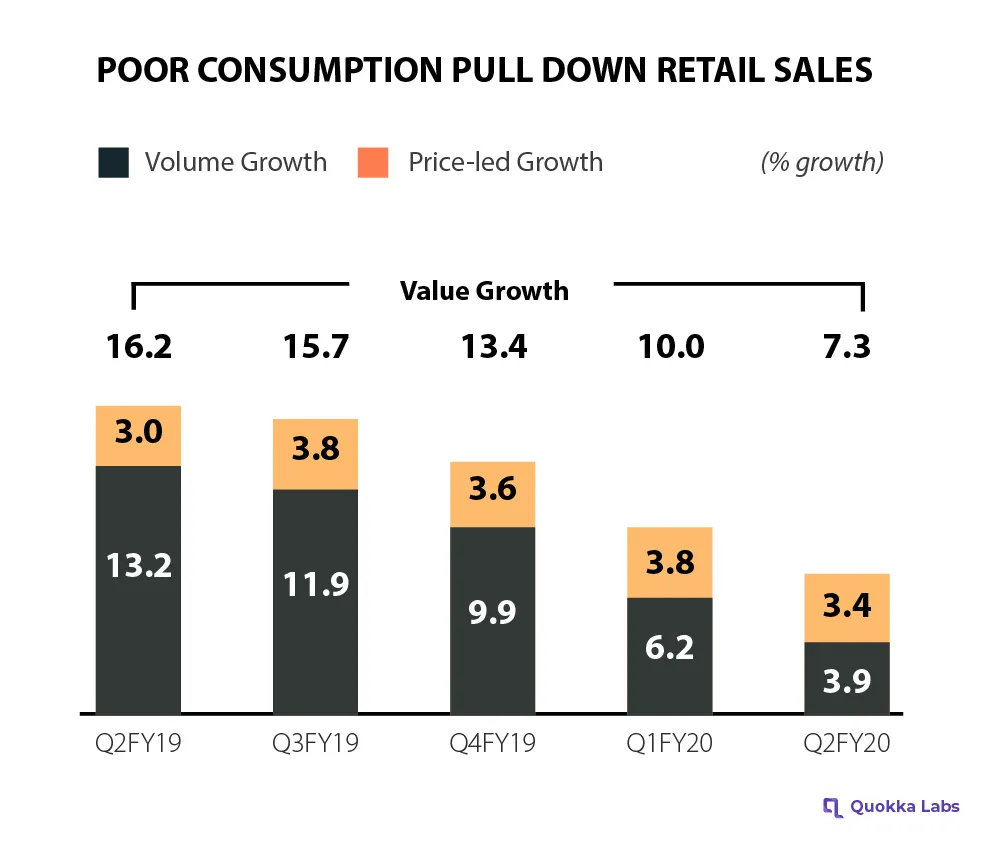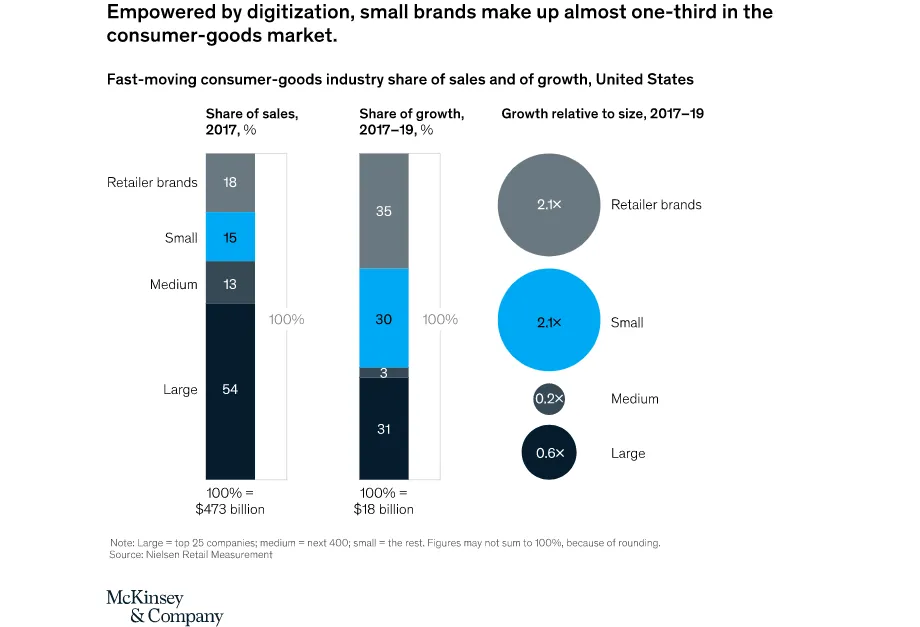Can the Digital World Transform the FMCG Market?
https://quokkalabs.com/blog/fmcg-market-digital-transformation/
The coming era will be all about various 'New Normals.
Technology and the increase in population and demands are pushing humans to search for ways to have easy, safe, and comfortable lives.
Thus, "if consumer companies seek to thrive into the future, they must adapt to new business models to quickly transform challenges into opportunities. Digital Transformation is one of many business models that will be adequate to help the FMCG market grow like never before!!"
Now, before jumping right into everything, let's see what this article includes for you:
- What is the FMCG market?
- Strengthen Brand Recognition
- Replace Offline Trading with Omnichannel Sales
- Automation in Production: A Necessity
- Understanding Consumer Behavior
- Win Loyalty via Customization
- Capitalizing on Immediate Demands
- Remote Customer Service: Chatbots & Voice Assistants
- Social Media & Digital Marketing: Personalized Ads
- Let's hear it from one of the FMCG giants!
- The human factor
What is the FMCG market?
You use soap, detergents, grains, food, beverages, hair oils, shampoos, other packaged food, juices, etc. They all fall under the category of Fast Moving Consumer Goods or FMCGs. These products are short shelf life. Because of their regular use, they are always in high demand. The market that deals with them is known as the FMCG market.
After ruling the micro-product industry for over half a century, the FMCG -fast-moving consumer goods - market is experiencing significant hurdles in keeping up with the extensive market share that it has been holding onto.
Digital marketing, e-commerce platforms, and automated productions are catalysts for scaling up the FMCG bulk to meet the latest trends.
The small and medium-scale manufacturers (SMEs/SMBs), which are strictly limited to retailers and grocery stores, face stiff competition from cheaper goods manufactured by local brands sold online through global brands like Amazon, etc.
Also, the prominent manufacturers, having yet to cultivate their brand value in the consumer market, are facing severe hurdles from branded market giants who rapidly encash digital transformation to gain brand recognition and visibility, resulting in more acceptance in the market.
Post World War 2, there are now 23 FMCG companies in the top 100 manufacturing giants in the world, maintaining an annual 15% TRS (Total Return to Shareholders), thus actively attracting investments for 45 long years. For example, P&G is one of them.
However, this journey has been hitting rough patches due to increased competition, exploding local brands, stocking-up issues, and other parameters.
Let's see how digital networking and mobility can help gain momentum in the FMCG market.
Strengthen Brand Recognition
Too many product launches in the FMCG market have threatened the brand value of the companies as, according to Nielson's study, only 0.2% of the new products gain influence among consumers. It can be visualized by the fact that out of 14,509 FMCG products launched in India, only 31 have been able to make their mark in the Rs. 2 lakh crore business.

The new buyers are living better lifestyles and prefer branded products more.
This declining growth rate is evidence that millennial consumption behavior is changing towards more branded products, i.e., the companies enjoying brand visibility are taking on the FMCG market.
FMCG giants - Johnson & Johnson, Hindustan Unilever, Himalaya, Lakmé, ITC, Godrej, P&G, and other companies that have dominated the FMCG market in India for decades are now competing with D2C-focused/Direct-to-customer business models.
If you go into detail about how much time market giants Revlon and Lotus took, they took around 20 years to reach USD 13.4 million revenue mark. In contrast, new startups take less time to surpass this mark. For example, Mamaearth reached this milestone in just four years of span.
How? And what technology or strategy helps?
The answer is robust digital marketing and transformation to attract potential buyers and make them believe Mamaearth is better than J&J and others!
Moreover, companies with dedicated websites register an 88% Year-on-Year rise in consumer demand. Following this, more businesses are adopting the D2C model. In India alone, more than 800 D2C brands are looking to reach USD 101 billion by 2025.
With the help of online product delivery companies like Amazon and Flipkart, the FMCG market is looking at new milestones to achieve.
Furthermore, in the era of OTTs and smartphones, advertising volumes on television still record healthy growth. And companies in the FMCG market continue to maintain their leadership position with significant growth in ad volumes, and even the e-commerce sector is showing healthy growth.

Thus, bringing the products live on websites, television, and mobile apps encourages online search and purchase. It is how you can improve your brand visibility among your consumers and potential buyers.
Marketing your products and services on mobile apps, websites, and television gives you an extra channel to sell and brings your brand closer to your customers, influencing brand recognition quickly.
Replace Offline Trading with Omnichannel Sales
FMCG product sales are mostly limited to grocery and retail stores, which only experience physical visibility. Instead of transporting bulk goods for sales, e-commerce platforms facilitate demand-based transportation, helping reduce delivery costs.
Such e-commerce platforms such as Meesho, Flipkart, Amazon, and Big Basket employ omnichannel trade, enhancing market presence and brand visibility, giving you an upper hand against local products that seldom sell online.
The 21-36 age group buyers are becoming more value-conscious: a byproduct of an evolving lifestyle. Hence, this is the right time to capitalize on digital disruptions and increase your brand recognition among the urban consumers who have been the main driving force of the FMCG market.
Automation in Production: A Necessity
Traditional manufacturing pipelines stress a company's goal of increasing production at lower costs to survive in the market.
In 2011, Harvard Business Review agreed that the adaptability of key market players to automation and robotic technology is necessary.
Manual transportation often relies on on-paper statistics that aren't updated in real-time and are prone to multiple errors.
Thus, heavy reliance on offline trading channels has decreased profit margins:
"FMCG companies' growth in TRS lagged the S &P 500 by three percentage points from 2012 to 2017."
Understanding Consumer Behavior
Consumer behavior has changed drastically with large-scale digital disruptions facilitated by internet penetration post-2017. While consumers shopping on e-commerce platforms focus more on brand value, grocery stores prioritize cost over the brand.
In both cases, FMCG companies are losing out due to non-existent brand recognition or declining profit in cheaper goods competition.
Mobile apps and websites give you an augmented analysis of organic visits, click-through rates, conversion ratio, etc., helping you with data to understand real-time purchasing behavior at the consumer level.
You can develop metrics-based sales strategies to meet your profit goals in this highly competitive market.
Win Loyalty via Customization
In a survey of retail industry leaders, nearly 40 percent said millennials' lack of loyalty is their #1 concern. It reflects that Millennials today are about 9% poorer than the last generation.
It pushes companies to devise a more customer-centric approach, possible only through digital adaptation. Trading in bulk makes your product vulnerable to price fluctuations locally and globally. Allowing customization wins you loyal users who will continue buying from you for a lifetime.
Comments
Post a Comment